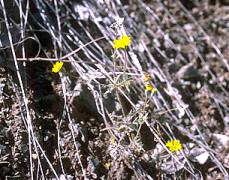Harmonia stebbinsii facts for kids
Quick facts for kids Harmonia stebbinsii |
|
|---|---|
 |
|
| Scientific classification | |
| Kingdom: | |
| (unranked): | |
| (unranked): | |
| (unranked): | |
| Order: | |
| Family: | |
| Genus: | |
| Species: |
H. stebbinsii
|
| Binomial name | |
| Harmonia stebbinsii (T.W.Nelson & J.P.Nelson) B.G.Baldw.
|
|
| Synonyms | |
|
Madia stebbinsii |
|
Harmonia stebbinsii is a special flowering plant. It is also known as Stebbins' tarweed or Stebbins' madia. This plant belongs to the aster family, which includes sunflowers and daisies.
Stebbins' tarweed is found only in northern California. This means it is endemic to that area. It grows in the Klamath Mountains and nearby parts of the North Coast Ranges. You can find it in unique, rocky areas called serpentine soils, usually at high places between 1100 and 1600 meters (about 3,600 to 5,200 feet) above sea level.
This plant is a rare annual herb. An annual herb means it grows, flowers, and dies within one year. Its stem can grow up to about 25 centimeters (10 inches) tall. The stem is bristly and has sticky black resin glands. Its bristly leaves are about 2 centimeters (less than an inch) long and grow mostly near the bottom of the plant.
The plant's inflorescence (flower cluster) has many small flower heads. These heads are covered with hairy, sticky, purple-tipped phyllaries. Each head has a few yellow ray florets (like petals) that are several millimeters long. It also has yellow disc florets in the center. After flowering, the plant produces a fruit called an achene, which has a feathery top called a pappus.
Where Stebbins' Tarweed Lives
Stebbins' tarweed is a rare plant found only in California. It is considered an endangered species. This plant especially likes shallow, rocky serpentine soils. For a long time, the California Native Plant Society thought it was a species of special concern. This was based on surveys done by US Forest Service scientists.
Today, Stebbins' tarweed is on the California Rare Plant Rank 1B.2. This means it is rare and endangered in California. You can only find it in a small area. This area includes Lake, Shasta, Tehama, and Trinity counties in California's Klamath Mountain Ecoregion. It has not been found anywhere else.
Special Serpentine Soils
The "serpentine" soils in California are very unique. They are also called ultramafic soils. These soils support many endemic plants, meaning plants found nowhere else. Over a long time, plate movements and erosion create these special soil environments.
Serpentine soils have a lot of magnesium and iron silicate materials. But they have very low levels of important plant nutrients. These nutrients include nitrogen, phosphorus, potassium, and calcium. On top of that, these soils contain tiny amounts of minerals that are harmful to most plants. These include cobalt, chromium, and nickel.
California has about 2,300 square miles (about 6,000 square kilometers) of these ultramafic rocks. Plants that grow in these places are very special. They have learned to adapt and grow even with these tough conditions. Because the environment is so extreme, it helps create many unique plant species. Few plant species can survive and thrive in a serpentine plant community.
Among all the plants found only in California, those from the Asteraceae family (like Stebbins' tarweed) are especially good at growing in serpentine soils. Most of these unique serpentine plants are found in the North Coastal and Klamath Mountain Ranges of northwestern California and southwestern Oregon.

